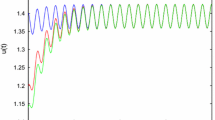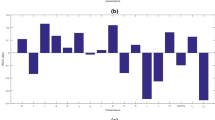Abstract
In this work, a predator–prey model has been proposed to study the impact of sea wave on the system dynamics. Since the predation success of predator species is inextricably related with the amount of sea wave, so a predation efficiency function of wave flow has been introduced in the model system. The well-posedness of the proposed system has been established by proving the positivity, boundedness, and persistence properties. All the equilibrium points have been found along with their parametric conditions of existence. The local stability analysis of all the equilibrium points and global stability analysis of the interior equilibrium point have been studied. Both the analysis of trans-critical bifurcation and Hopf-bifurcation have been performed in a systematic way. It can be seen from the model analysis that the stability of the system dynamics is greatly influenced by both the wave and conversion rate parameters. Additionally, the wave parameter has an immense impact on the population densities of both species. Furthermore, a non-autonomous version of the suggested model system has been created by using the wave flow parameter as a time-dependent periodicity function to take into account the seasonality phenomenon. It has been discovered that the seasonally-forced system exhibits a wide spectrum of dynamical scenarios including bursting phenomenon in the system dynamics. All of the analytical results have been supported suitably by extensive numerical simulations.















Similar content being viewed by others
Data Availibility Statement
Data sharing is not applicable to this article as no new data were created or analyzed in this study.
References
J.F. Andrews, A mathematical model for the continuous culture of microorganisms utilizing inhibitory substrates. Biotechnol. Bioeng. 10(6), 707–723 (1968)
I. Hanski, The Functional Response of Predators: Worries About Scale (1991)
C.S. Holling, The components of predation as revealed by a study of small-mammal predation of the European pine sawfly1. Can. Entomol. 91(5), 293–320 (1959)
C.S. Holling, Some characteristics of simple types of predation and parasitism1. Can. Entomol. 91(7), 385–398 (1959)
P.A. Braza, The bifurcation structure of the Holling–Tanner model for predator-prey interactions using two-timing. SIAM J. Appl. Math. 63(3), 889–904 (2003)
C. Cosner, D.L. DeAngelis, J.S. Ault, D.B. Olson, Effects of spatial grouping on the functional response of predators. Theoret. Popul. Biol. 56(1), 65–75 (1999)
D. Xiao, S. Ruan, Global analysis in a predator-prey system with nonmonotonic functional response. SIAM J. Appl. Math. 61(4), 1445–1472 (2001)
M. Fan, Y. Kuang, Dynamics of a nonautonomous predator-prey system with the Beddington–Deangelis functional response. J. Math. Anal. Appl. 295(1), 15–39 (2004)
S. Gakkhar, R.K. Naji, Seasonally perturbed prey-predator system with predator-dependent functional response. Chaos Solitons Fractals 18(5), 1075–1083 (2003)
R. Arditi, L.R. Ginzburg, Coupling in predator-prey dynamics: ratio-dependence. J. Theor. Biol. 139(3), 311–326 (1989)
H. Freedman, R. Mathsen, Persistence in predator-prey systems with ratio-dependent predator influence. Bull. Math. Biol. 55(4), 817–827 (1993)
X. Wang, L. Zanette, X. Zou, Modelling the fear effect in predator-prey interactions. J. Math. Biol. 73(5), 1179–1204 (2016)
J. Roy, D. Barman, S. Alam, Role of fear in a predator-prey system with ratio-dependent functional response in deterministic and stochastic environment. Biosystems 197, 104176 (2020)
D. Barman, J. Roy, S. Alam, Trade-off between fear level induced by predator and infection rate among prey species. J. Appl. Math. Comput. 64(1), 635–663 (2020)
J.P. Gibert, Temperature directly and indirectly influences food web structure. Sci. Rep. 9(1), 5312 (2019)
U. Daugaard, O.L. Petchey, F. Pennekamp, Warming can destabilize predator-prey interactions by shifting the functional response from type iii to type ii. J. Anim. Ecol. 88(10), 1575–1586 (2019)
D. Barman, J. Roy, S. Alam, Impact of wind in the dynamics of prey-predator interactions. Math. Comput. Simul. 191, 49–81 (2022)
D. Barman, V. Kumar, J. Roy, S. Alam, Modeling wind effect and herd behavior in a predator-prey system with spatiotemporal dynamics. Eur. Phys. J. Plus 137(8), 1–28 (2022)
M.J. Bishop, Displacement of epifauna from seagrass blades by boat wake. J. Exp. Mar. Biol. Ecol. 354(1), 111–118 (2008)
F. Gabel, X.-F. Garcia, M. Brauns, A. Sukhodolov, M. Leszinski, M. Pusch, Resistance to ship-induced waves of benthic invertebrates in various littoral habitats. Freshw. Biol. 53(8), 1567–1578 (2008)
C. Wolter, R. Arlinghaus, Navigation impacts on freshwater fish assemblages: the ecological relevance of swimming performance. Rev. Fish Biol. Fish. 13, 63–89 (2003)
C. Wolter, R. Arlinghaus, A. Sukhodolov, C. Engelhardt, A model of navigation-induced currents in inland waterways and implications for juvenile fish displacement. Environ. Manage. 34, 656–668 (2004)
S. Stoll, P. Fischer, Three different patterns of how low-intensity waves can affect the energy budget of littoral fish: a mesocosm study. Oecologia 165, 567–576 (2011)
D. Smee, Environmental context influences the outcomes of predator-prey interactions and degree of top-down control. Natl. Educ. Knowl. 3, 58 (2012)
E.M. Robinson, D.L. Smee, G.C. Trussell, Green crab (Carcinus maenas) foraging efficiency reduced by fast flows. PLoS ONE 6(6), e21025 (2011)
T.A. Keller, M.J. Weissburg, Effects of odor flux and pulse rate on chemosensory tracking in turbulent odor plumes by the blue crab, Callinectes sapidus. Biol. Bull. 207(1), 44–55 (2004)
D.L. Smee, M.J. Weissburg, Hard clams (Mercenaria mercenaria) evaluate predation risk using chemical signals from predators and injured conspecifics. J. Chem. Ecol. 32(3), 605–619 (2006)
S.P. Powers, J.N. Kittinger, Hydrodynamic mediation of predator-prey interactions: differential patterns of prey susceptibility and predator success explained by variation in water flow. J. Exp. Mar. Biol. Ecol. 273(2), 171–187 (2002)
D.L. Smee, M.C. Ferner, M.J. Weissburg, Hydrodynamic sensory stressors produce nonlinear predation patterns. Ecology 91(5), 1391–1400 (2010)
J. Gupta, J. Dhar, P. Sinha, An eco-epidemic model with seasonal variability: a non-autonomous model. Arab. J. Math. 11(3), 521–538 (2022)
M. Izadi, Ş Yüzbaşı, W. Adel, Accurate and efficient matrix techniques for solving the fractional Lotka–Volterra population model. Physica A 600, 127558 (2022)
G.-Q. Sun, Z. Jin, L. Li, Q.-X. Liu, The role of noise in a predator-prey model with Allee effect. J. Biol. Phys. 35, 185–196 (2009)
M. Weissburg, C. James, D. Smee, D. Webster, Fluid mechanics produces conflicting, constraints during olfactory navigation of blue crabs, Callinectes sapidus. J. Exp. Biol. 206(1), 171–180 (2003)
A. S. Purnomo, I. Darti, A. Suryanto, Dynamics of eco-epidemiological model with harvesting, in: AIP Conference Proceedings, Vol. 1913, AIP Publishing LLC, (2017), p. 020018
A. Chatterjee, S. Pal, Switching effects driven by predation on diffusive predator prey system. Appl. Appl. Math. Int. J. (AAM) 16(1), 38 (2021)
C. Jørgensen, R.E. Holt, Natural mortality: its ecology, how it shapes fish life histories, and why it may be increased by fishing. J. Sea Res. 75, 8–18 (2013)
A. Mandal, P.K. Tiwari, S. Samanta, E. Venturino, S. Pal, A nonautonomous model for the effect of environmental toxins on plankton dynamics. Nonlinear Dyn. 99(4), 3373–3405 (2020)
A. Mandal, P.K. Tiwari, S. Pal, A nonautonomous model for the effects of refuge and additional food on the dynamics of phytoplankton-zooplankton system. Ecol. Complex. 46, 100927 (2021)
S. Biswas, P. Kumar Tiwari, S. Pal, Effects of toxicity and zooplankton selectivity on plankton dynamics under seasonal patterns of viruses with time delay. Math. Methods Appl. Sci. 45(2), 585–617 (2022)
S. Biswas, P.K. Tiwari, S. Pal, Delay-induced chaos and its possible control in a seasonally forced eco-epidemiological model with fear effect and predator switching. Nonlinear Dyn. 104(3), 2901–2930 (2021)
F. Chen, On a nonlinear nonautonomous predator-prey model with diffusion and distributed delay. J. Comput. Appl. Math. 180(1), 33–49 (2005)
R.E. Gaines, J.L. Mawhin, Coincidence Degree and Nonlinear Differential Equations, vol. 568 (Springer, Cham, 2006)
A. Huppert, B. Blasius, R. Olinky, L. Stone, A model for seasonal phytoplankton blooms. J. Theor. Biol. 236(3), 276–290 (2005)
Funding
There is no funding for pursuing this research article.
Author information
Authors and Affiliations
Contributions
DB: Conceptualization, Formal analysis, Investigation, Software, Writing - original draft. SN: Formal analysis, Investigation, Visualization, Writing - original draft. AM: Methodology, Project administration, Validation, Writing - review & editing. SA: Conceptualization, Investigation, Methodology, Project administration, Supervision, Writing - review & editing.
Corresponding author
Ethics declarations
Conflict of interest
The authors declare that there is no conflict of interests regarding the publication of this article.
Ethical approval
The authors state that this research complies with ethical standards. This research does not involve either human participants or animals.
Rights and permissions
Springer Nature or its licensor (e.g. a society or other partner) holds exclusive rights to this article under a publishing agreement with the author(s) or other rightsholder(s); author self-archiving of the accepted manuscript version of this article is solely governed by the terms of such publishing agreement and applicable law.
About this article
Cite this article
Barman, D., Naskar, S., Mandal, A. et al. Impact of seasonal variability of sea waves on the dynamics of a predator–prey system. Eur. Phys. J. Plus 138, 641 (2023). https://doi.org/10.1140/epjp/s13360-023-04295-5
Received:
Accepted:
Published:
DOI: https://doi.org/10.1140/epjp/s13360-023-04295-5




